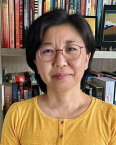 Sayuri Miyamoto, PhD
Sayuri Miyamoto, PhD
University of Sao Paulo
Prepared by: Isabelle Logan
How did your scientific journey start, and how did you enter the field of redox biology?
I graduated from the Pharmacy & Biochemistry course at the University of São Paulo. After finishing my bachelor's degree, I went to Japan to specialize in research.
In Japan I worked for 5 years in the research laboratory coordinated by Junji Terao. First as an intern at the NFRI lipid research laboratory in Tsukuba and then as a master's student at Tokushima University. During this period, Japan has led several projects in natural antioxidants and functional foods. My first project was to synthesize a new and more hydrophilic vitamin E derivative containing a phosphate group. The research group was investigating in carotenoid and flavonoids with a focus on preventing oxidative damage in biological system and my project was focused on metal chelating properties of inositol hexaphosphate (phytic acid).
During this period, I have got interested in understanding the molecular aspects of enzymatic and non-enzymatic reactions involving lipid hydroperoxides. Still in Japan, I was involved in studies on phospholipid hydroperoxide repair processes involving phospholipaseA2 and GPx4. Then, for personal reasons I returned to Brazil where I continued to study reactions of lipid hydroperoxides under the supervision of Paolo Di Mascio. My project was to study mechanisms for generating singlet oxygen from lipid hydroperoxides. I published important works on the subject and obtained a position as an assistant professor in the Department of Biochemistry at the Institute of Chemistry at USP in 2007 where I continue working on projects in redox biology with a focus on the study of reactivity, metabolism and functional role of oxidized lipids using mass spectrometry-based omics analysis tools.
You lead an impressive research program. Could you tell us more about your CEPID-Redoxoma, and how discoveries are transferred to the public and private sectors?
CEPID-Redoxoma is a long term (11 years) research project supported by São Paulo Research Foundation – FAPESP coordinated by Ohara Augusto (director) and Francisco Laurindo (vice-director). It started in 2013 and has approximately 25 researchers and several national and international collaborators. Activities in the CEPID-Redoxoma are divided into four major areas. Three of them are focused on basic aspects related to the generation and control of oxidants and radicals in biological systems, chemical reactivity and redox signaling while the fourth area is focused on the applied and translational aspects of redox processes. So, alongside investigations in the basic science, CEPID-Redoxoma activities include innovation and technology transfer and education dissemination. The center has various projects with different stakeholders: hospital, startups, and companies. Successful examples are the development redox reactors to treat industrial effluents, formulations to protect skin against UV and visible light and pre-clinical studies aiming to test the therapeutic efficacy of compounds and to develop disease biomarkers. To support research activities the center also has a multi-user redox analytical platform with state-of-the-art instruments (e.g. high resolution LC-MS platforms) for the quantification of biomolecule redox alterations and redox changes in metabolism.
Have you encountered outstanding mentors who shaped your scientific career? How did they help your growth as a scientist, and what tactics do you currently employ to aid the growth of young burgeoning scientists?
Yes, I am fortunate to have encountered mentors that guided me and stimulated me to continue in the scientific area. When I was an undergrad student, I didn't know if I wanted to stay in academia because the research conditions and salaries were not so good. As a pharmacist, I could have jobs in industry that could offer much better conditions. However, my first mentor of the scientific initiation (Massami Shimokomaki) stimulated me to continue in the research field. So, as I mentioned above, I went to Japan after finishing my graduation. This completely changed my career. Working in the research in Japan was remarkable for me and decided that I wanted to continue in the research area. My mentor in Japan (Junji Terao) introduced me into the redox biology field. In his laboratory I became interested to understand the molecular aspects of lipid peroxidation and the physiological and pathological roles of lipid redox modifications. As a mentor, he always stimulated attending conferences and develop my network. Back to Brazil, I wanted to continue studying mechanisms involving lipid hydroperoxide reactions in biological system. I was lucky to find a stimulating scientific environment at the Institute of Chemistry in the laboratory of Paolo Di Mascio where I learned about the chemistry and reactions of singlet oxygen and the advanced analytical tool such as mass spectrometry. Also, I learned interesting histories about the research that was done when he was in Germany working with Helmut Sies. As a mentor, I try to stimulate the curiosity and critical scientific thinking. Also, whenever possible I recommend students to attend scientific meetings because it is important to present your data, have discussions and do networking.
What excites you the most about basic science?
What excites me most about basic research is that we are in the boundaries of science. So, discoveries can be transformative and impact our future. Of course, we cannot make new discoveries every day. But understanding basic science is fundamental to develop more effective therapeutic strategies and to improve the quality of life and this is what most excites me about basic science.
What is your advice to those new in the redox biology field?
Understand the basics of reactive oxygen species, especially the fundament behind the methodologies used for their quantification. There is a general use of unspecific methods. The use of precise and specific methodologies is critical to advance studies in any scientific area. Also, I highly recommend attending the SfRBM and SFRRI meetings where you will have the opportunity always learn the basics of redox biology in the free radical school, get updated with the most recent advancements in the area and interact with many important scientists in the redox biology field.